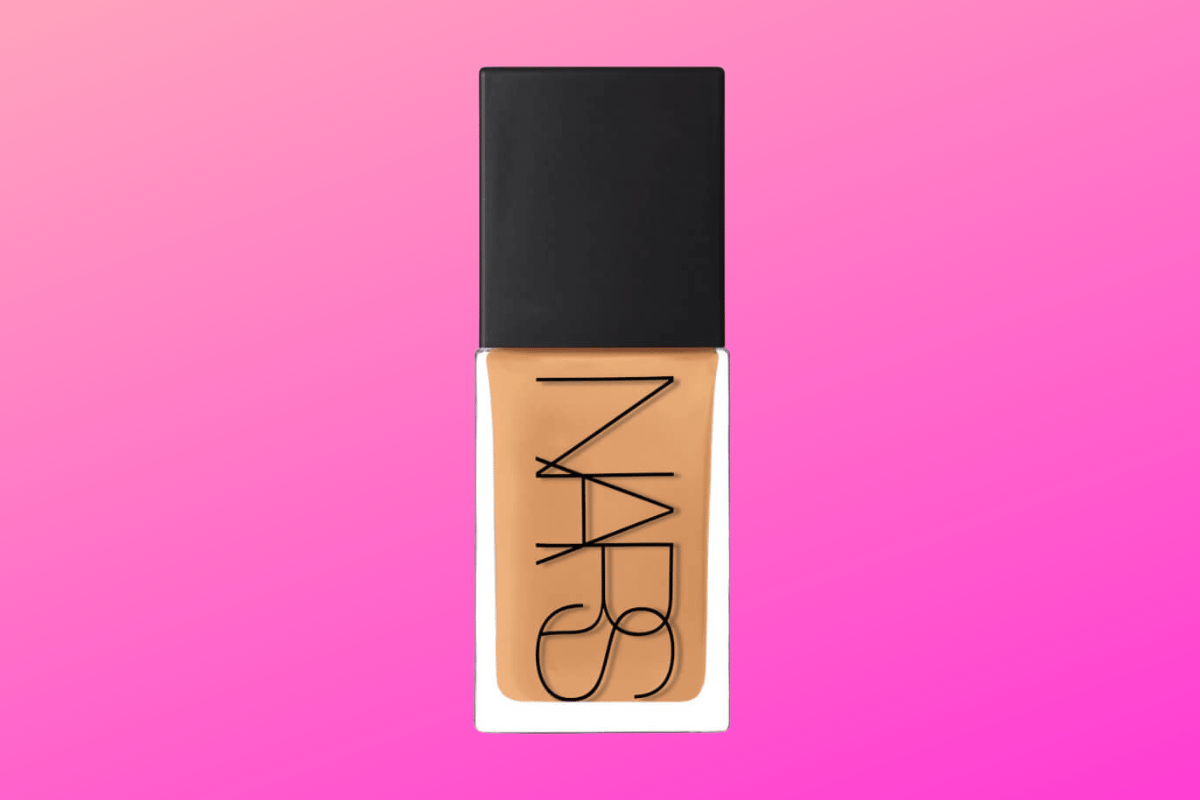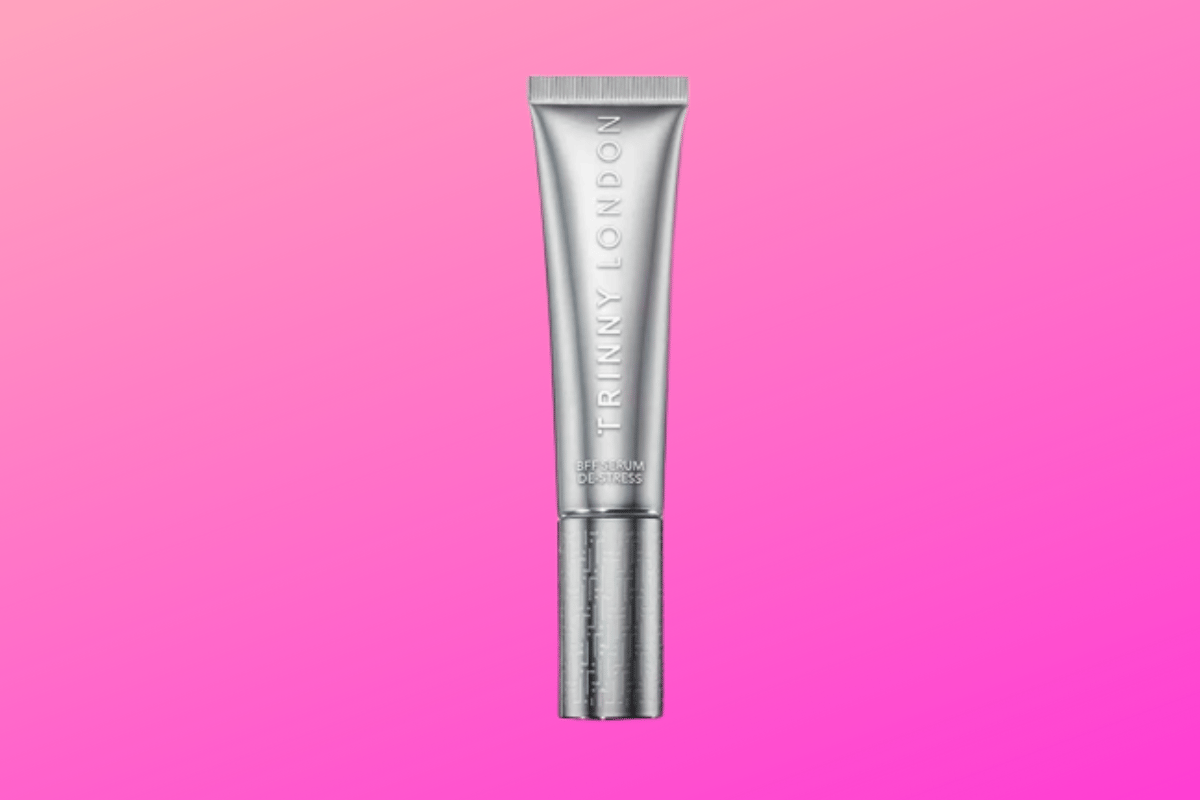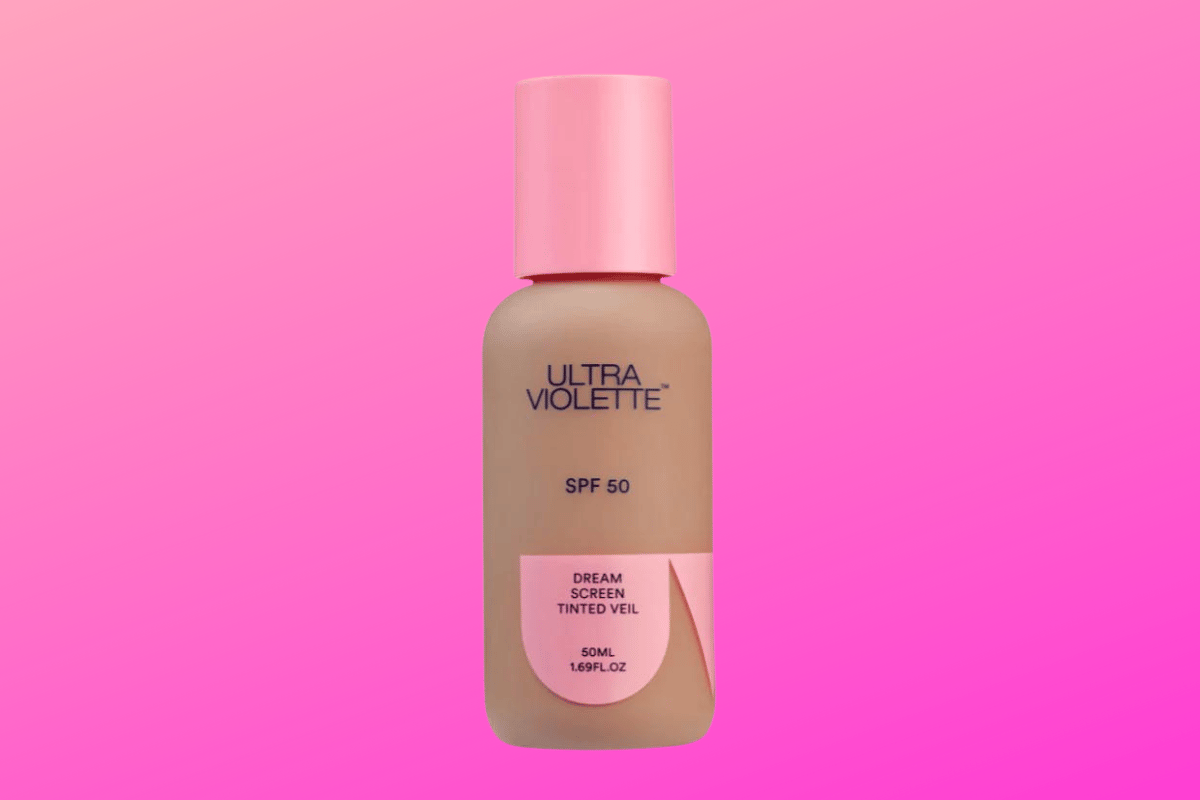
A question for you: When was the last time you updated your makeup look? You know, switched up your usual routine?
We're nosy, we know. But hear us out. Because the thing is - your skin changes a lot as you shimmy on into your 40s and 50s. And once you hit perimenopause, you'll start to notice even more changes.
Things like lines and wrinkles around your mouth, forehead and eyes, maybe some pigmentation, dryness and all that other fun stuff. This means that makeup starts to sit differently on our faces.
That's why Mia Freedman sat down with celebrity makeup artist Rae Morris in a three-part series, to nut out exactly what tweaks we can make to our makeup routines as we age - starting with, quite literally, the foundation.
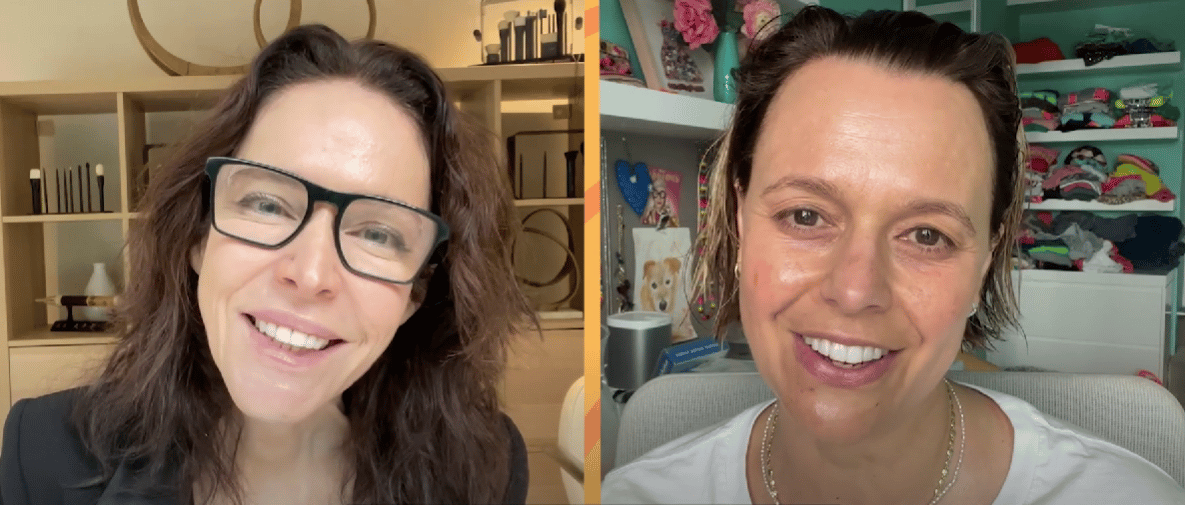 Image: Rae Morris and Mia Freedman.
Image: Rae Morris and Mia Freedman.
Here's exactly what Rae Morris told Mia Freedman to do when it comes to nailing her makeup base.
Ready? Grab your brush and let's go.
1. When it comes to foundation, less is more.
While there are some very good formulas out there for mature skin, more often than not, you'll probably find that they all just end up hanging out in your fine lines. Right?
Well, as Rae tells Mia, a lot of it comes down to how much foundation you're putting on your face. Because when it comes to foundation and mature skin, apparently more... does not equal more.
"When we get older, our skin has more movement, so you have to put less on the skin," she said.
"The more foundation you put on it, the more it's going to crease. It's all about using products with the pigment that you want, but using less amount because our faces are more flexible."
The amount you apply can mean the difference between lovely, even and healthy looking skin, and heavy, crepey skin.
For Mia, she tells Rae she's more partial to a tinted moisturiser as opposed to something heavier.
Some of Mia's faves include NARS Light Reflecting Foundation ($73), Trinny London BFF Rebalance Serum Foundation ($75) and Ultraviolette Dream Screen SPF50 Tinted Veil, $55.
All good choices!
Rae also recommends IT Cosmetics Your Skin But Better CC+ Cream SPF 50, $65.
"Find the coverage that you want - the best option for you (you're always better to get something with a bit more coverage) - but use less of it. You don't want to be in that world of piling on this layer, then that layer, and then a sheer one."
And forget that word 'buildable' when it comes to foundation - because, as Rae said, for mature skin, it can just be too much.
"Less is best!"
2. Focus on an even skin tone above everything else.
According to Rae, there's one goal we all need to focus on when it comes to makeup for mature skin. And no - it's not smoothing out fine lines or wrinkles.
As Rae tells Mia, "I get to speak on a panel with plastic surgeons. Basically, my role is to help them make women and men more age appropriate. Because a lot of surgeries are not making women look younger - it's making them look weirder."
"But they're also finding that makeup can make you look ten, 20 years younger. So, it's about teaching the subtleties."
What are the subtleties? TELL US ABOUT THE SUBTLETIES, RAE.
"In a conference, one of the world's best plastic surgeons got up in a room full of only other plastic surgeons and the question was asked, 'If you had to do one thing to a woman to make her look younger, you can use any tool that you want, what would be the one thing that you would do?'
"And what he said floored me. He said, 'I wouldn't chase the wrinkles. I would even out the skin tone'."
Boom.
 Image: Rae Morris and Mia Freedman.
Image: Rae Morris and Mia Freedman.
"When he said that, he put a picture up of a woman in her seventies from Queensland. She smoked, drank, baked in the sun. She had - what we would call in the makeup world - salami skin."
Salami skin.
As Mia goes on to say, pigmentation and 'salami skin' is one of her chief skin concerns, and something that lingered around after pregnancy in her thirties.
According to Rae, this is a key factor of ageing.
"In one photo, he [the plastic surgeon] retouched all the wrinkles out of this woman's face - she didn't look younger; she looked odd. But in the second photo, he evened out her skin tone, and she looked 20 years younger. And I thought wow - as a makeup artist, even out your skin tone. That's just by using foundation."
"The most anti-ageing thing you can do is even out your skin tone," Rae tells Mia.
Interesting.
"When women get older, the biggest thing I would hear my mum say was, 'I want more colour on my skin. I feel dead. I've got no colour'. But when you add just colour - like on your lips or cheeks - if you don't even out the skin tone, you'll enhance all that pigmentation."
Meaning? If you want to add colour like a lip or cheek, you need to work on addressing any redness or pigmentation first.
3. A brush will give you the best foundation application.
So, you've been nailing number one and two, but your base still looks... meh.
It might not come down to your actual foundation, but the way you've been applying it.
When Mia asks Rae for her weapon of choice, she said, "I like a brush, because you can polish it out."
 Image: Rae Morris
Image: Rae Morris
"Fingers are great to get it on there, but the problem with fingers is - one, foundation gets everywhere, because it's greasy. And also you get fingerprint marks."
No good.
"What I like about a brush too is that it's a great way to take a thicker foundation and thin it down - it will make the foundation look flawless and it cuts the foundation time in half."
Rae recommends buffing it out down the neck to get the most seamless application, adding that when you're using your fingers to apply foundation, you never really know what the right amount is. "Whereas with a brush, it evens everything out."
"A brush is also really good for pockmarks and things like that because it just sort of goes over the top."
4. For concealer, never go over two shades away from your skin tone.
Hands up who thought you had to go super light when it comes concealers? Otherwise it won't brighten your under eyes, right?
Wrong.
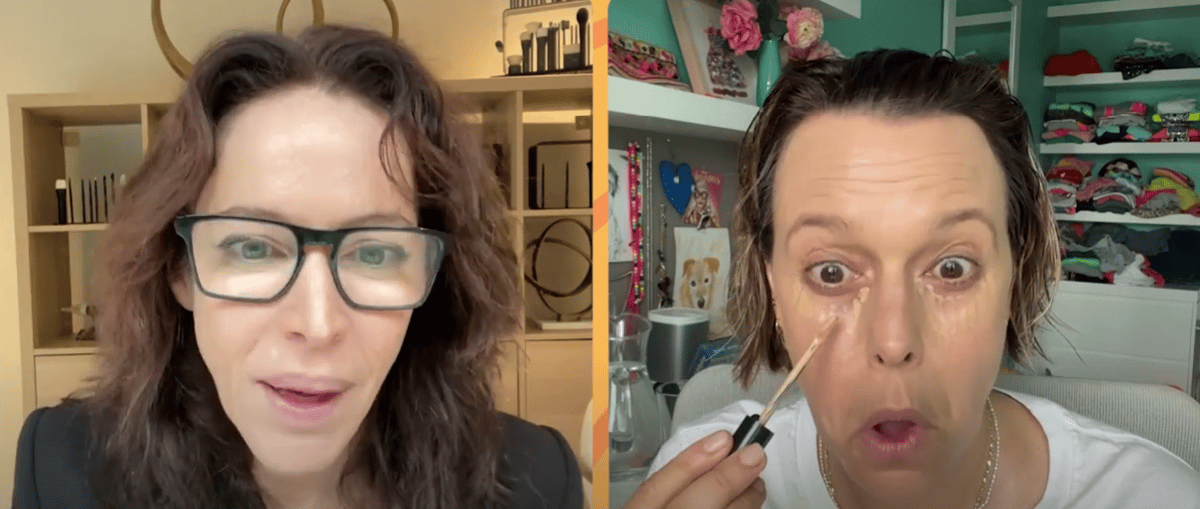 Image: Rae Morris and Mia Freedman.
Image: Rae Morris and Mia Freedman.
Mia tells Rae one of the main things she's learnt from her is to match your skin tone with concealer - not go lighter. Because apparently it turns your under eyes... grey.
"The second you move two shades away from your skin colour, you make everything ash. [What] you're better off doing is going one shade lighter for under the eye," said Rae.
5. Bring your foundation right under your eyes.
Another trick? When applying your foundation, take it right up and blend it under your eyes.
"Pull it up [under the eye] because that's going to knock out 80 per cent of any discolouration," said Rae.
This way, you might not even need concealer under your eyes.
"I just use it right on the inner corners of my eyes [to cover] that dark blueness there," said Rae. "If you bring your foundation right up there, you'll also get a more even colour."
"We aren't all colour theory scientists," said Rae.
*Takes off lab coat*
"You never know how light or dark your concealer is and sometimes all those brightening concealers are a trick and they're not great - they're too shimmery. They say they reflect light, but a shimmer is dangerous where wrinkles and lines are concerned."
Those sneaky buggers.
6. Keep away from shimmer.
Just on the whole shimmer thing, Mia tells Rae that she was utterly obsessed with all things sparkly and shimmery, until she reached her forties and realised it wasn't... going well.
So should people with mature skin really avoid shimmer and glitter? Or is that just a big myth?
"I think of the word fish scale," Rae tells Mia. [Shimmer] makes the skin look like fish scales."
"If you don't believe me, get a shimmery product and put it on the back of your hand and you'll notice every single wrinkle you never thought you had."
OKAY, COOL. WE'RE FINE.
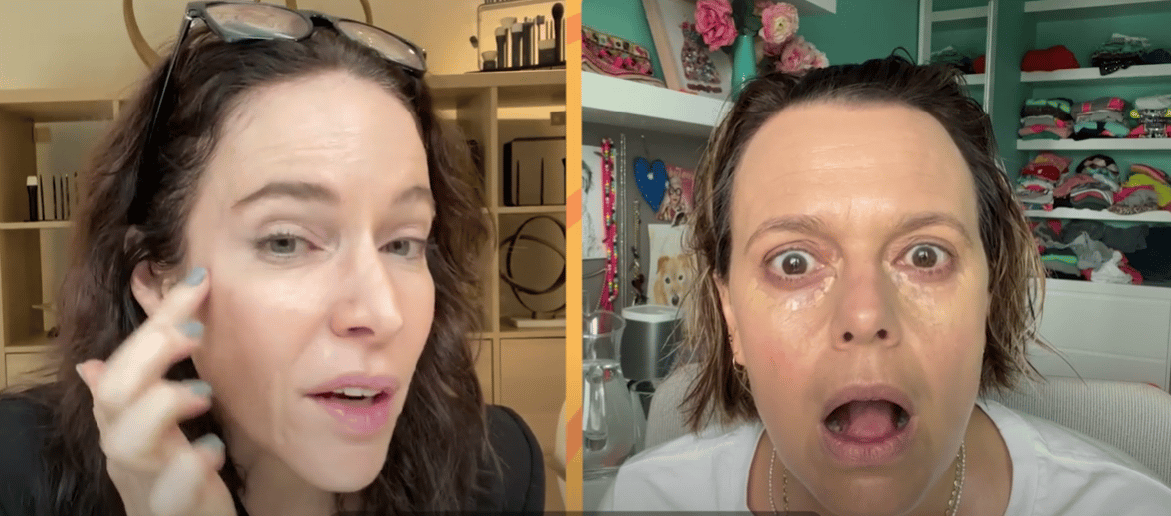 Image: Rae Morris and Mia Freedman
Image: Rae Morris and Mia Freedman
Can confirm: Mia was not fine.
"So, shimmer can go," she adds. "The eyelids are fine... but if you have wrinkly eyelids - keep away from shimmering."
Rae also recommends keeping away from the shimmery highlighter around the outside of your eyes/temple area, telling Mia, "When we smile - everything creases. If you're going to highlight this area, pull it further away."
"Keep away from glitters and metallic shimmery colours - they do work on eyelids, but I find it's more about the crepeiness and keeping away all shine from our hooded areas."
7. Don't put concealer on your lids.
When it comes to where you're not supposed to put concealer, Rae said your eyelids generally don't need it.
"If you're using cream eyeshadows, normally there's enough pigment in them to cover the blueness undertone that we all have in our eyelids."
Instead, she tells Mia to use foundation on her lids.
"If you are going to use a natural colour, I would put a wash of foundation, because what you want to do is get that skin tone even."
Why foundation instead of concealer?
Rae said, "The way I explain it, it's like putting eyeshadow on your fingertip versus the back of your hand."
Go on, compare them! They're pretty different, huh?
"Eyelids can have a blue-red undertone, so colours can be a bit muted. But if you make your skin tone more even, any colour you put on there will go true. The reason I say foundation is that it's just thinner."
"Your eyelids are really thin. Think of it like the tip of your nose. They don't hold concealer very well - that's why your eyeshadow creases."
"The one thing people forget is that your eyelids are one of the oiliest parts of your face. You think your t-zone is oily? Eyelids are oilier!"
8. Rose coloured blush suits everyone.
One of the main questions Mia had for Rae? Blush.
More specifically, how do you know which colour you should use?
Because there are so many options. So many brands. Creams. Powders. Tints. What kind are you supposed to go for? Well, apparently there's a universal colour for EVERY face.
"A rosy coloured blush suits everybody because it's our natural skin tone - that beautifully flushed, pinky tone."
"People get afraid of blush because [they think], 'Oh, my skin's really red,' - but again, you've got to take the redness away to put it where you want it."
So, if you're struggling to find a colour tone that suits you, opt for any rose coloured/mahogany blush.
Rae also said that if you like to wear more gold jewellery, you can go with apricot shades and peachy shades.
"The good thing with blush is you can't actually go too wrong. Just don't put too much on."
And again, stay away from sparkly formulas. Matte is your friend here.
"Anything with a shimmer in it will actually go two to three shades lighter in the sun, but go three to four shades darker in the shade," said Rae.
She goes on to explain that when we get older, our cheeks sink down - and we get a hollow.
"When we're younger, our cheeks sit up nice and high. When we get older, they drop down - so you don't want to have blush in this hollow area."
This brings attention down to your mouth and jawline area when you want to lift the attention upwards.
"A great line to remember is the corner of your lip to the top of your ear - keep it above that line and you want to go nice and high and rounded," Rae tells Mia.
And the smile and blush thing? That's apparently a big no.
"My cheeks aren't where they used to be - so when I smile, and put blush on here, I can create a hole in my face," said Rae.
You heard her. Everything's gotta come up.
9. What comes first - foundation or concealer?
Apparently it doesn't matter. After all this time!
The same goes for blush.
"Blush can go anytime, really. It's one of those things that when you finish your makeup, I always look and go - I either need more blush or less blush. It's one of those things I tweak at the end," said Rae.
Wanna check out the video? Head here.
Keen to know more of what Mia's learned about skincare and the changes she made in her 40s? You can read about that here, or take a peek at the two serums Mia Freedman uses every day.
Feature image: Mamamia
Love all-things beauty? Take this short survey now to go in the running to win a $50 gift voucher!

